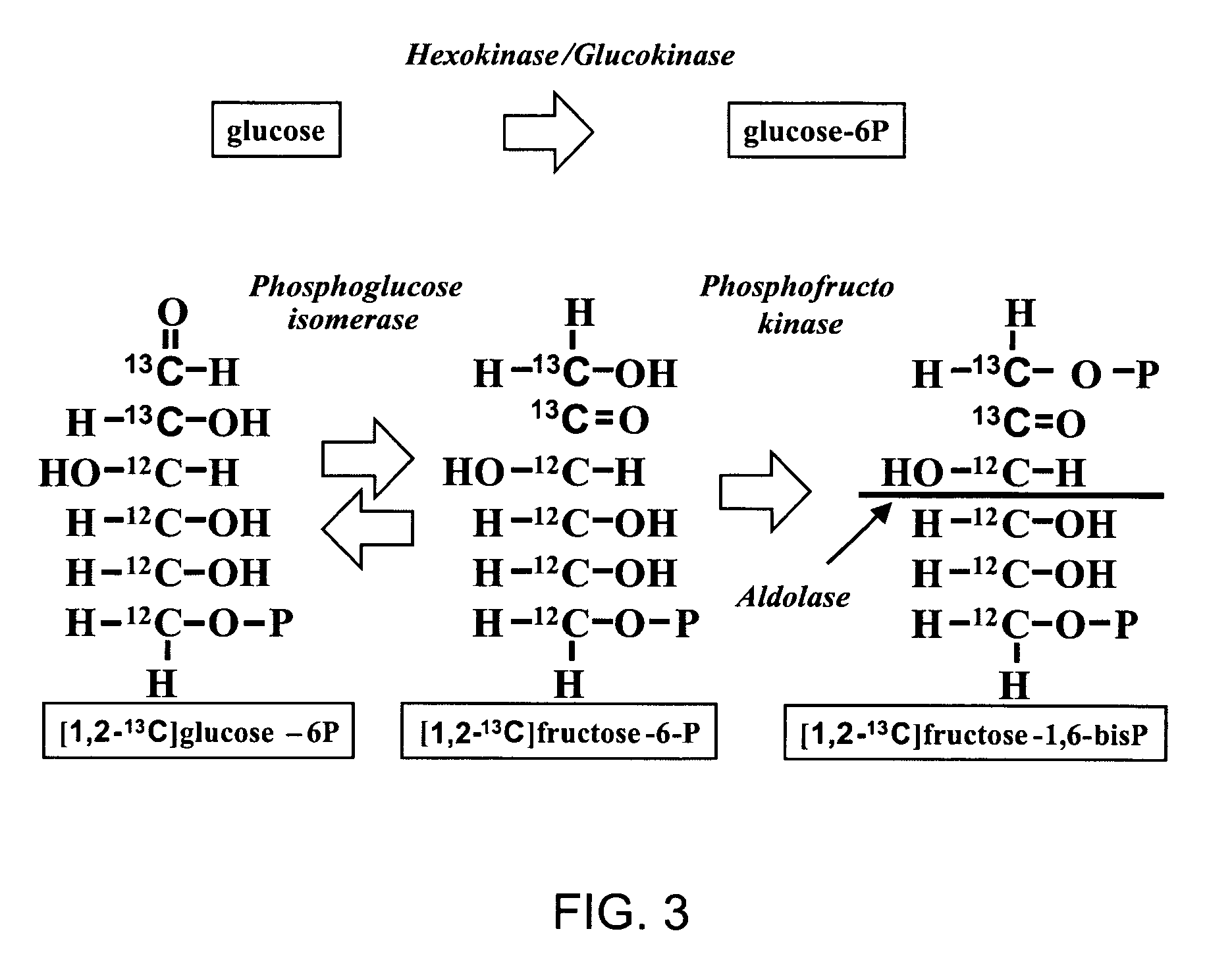Method of enhancing the efficiency of a pharmaceutical business
a technology of efficiency and pharmaceutical business, applied in the field of doing business, can solve the problems of inability to determine the screen, the mechanism of action the pathway of the drug or drug candidate, so as to improve the ability of organizations to identify
- Summary
- Abstract
- Description
- Claims
- Application Information
AI Technical Summary
Benefits of technology
Problems solved by technology
Method used
Image
Examples
example 1
[0099] The details of how the invention can be carried out can be better understood by reference to the figures. For example, FIG. 3 shows the structure of a preferred embodiment of a labeled glucose molecule along with possible rearrangements of 13C in various metabolites of glycolysis using [1,2-13C2]glucose as the single tracer. Glucose activation via hexokinase / glucokinase and the formation of fructose-1,6-bisphosphate maintain the 13C labeled carbons in the 1st and 2nd positions. 13C-labeled carbon positions derived from [1,2-13C2]glucose are shown by the “13” superscript, while 12C native-labeled carbon positions are shown by the “12” superscript. Participating enzymes are italicized in all of the figures. To carry out the invention [1, 2-13C2] glucose is added to a cellular system and tracked through a biochemical pathway such as the pentose cycle, glycogen synthesis, tricarboxylic acid cycle, glycolysis, lactate synthesis, glutamate production, fatty acid synthesis and nucle...
example 2
[0100] In addition to labeling glucose as shown in FIG. 3, it is possible to label glucose at other positions and / or to label other molecules such as [2,3-13C] dihydroxy acetone-P or to continue to track the molecule of [2,3-13C2]dihydroxy acetone-P created in the reaction show in FIG. 3. FIG. 4 shows the structure of the labeled compounds involved in the formation of [2,3-13C2]lactate through the Embden-Meyerhoff-Pamas pathway. The production of three-carbon metabolites by aldolase (as shown in FIG. 3), glyceraldehyde and dihdroxy acetone phosphates transfers the labeled carbons into the 2nd and 3rd positions of glyceraldehyde. There are no subsequent positional changes in terms of 13C labeling by triose phosphate isomerase in the three-carbon metabolite pool that undergoes glycolysis, resulting in the release of lactate.
example 3
[0101] The labeled glucose as shown in FIG. 3 can be acted on differently as the reactions of FIG. 5 show. FIG. 5 shows the structure of compounds involved in the rearrangement of 13C in pentose cycle metabolites due to direct glucose oxidation. The loss of the first labeled carbon of glucose due to direct oxidation produces ribulose molecules that are labeled only on the first position with 13C. During the oxidation of glucose 13CO2 is released, which can easily be detected using isotope ratio mass spectrometry (IRMS). Reducing equivalent NADP+ is also produced that can be used in lipid synthesis, DNA nucleotide production or to maintain reductive / oxidative reactions throughout metabolism.
PUM
| Property | Measurement | Unit |
|---|---|---|
| molecular weight | aaaaa | aaaaa |
| gas chromatography | aaaaa | aaaaa |
| mass spectrometry | aaaaa | aaaaa |
Abstract
Description
Claims
Application Information
 Login to View More
Login to View More - R&D
- Intellectual Property
- Life Sciences
- Materials
- Tech Scout
- Unparalleled Data Quality
- Higher Quality Content
- 60% Fewer Hallucinations
Browse by: Latest US Patents, China's latest patents, Technical Efficacy Thesaurus, Application Domain, Technology Topic, Popular Technical Reports.
© 2025 PatSnap. All rights reserved.Legal|Privacy policy|Modern Slavery Act Transparency Statement|Sitemap|About US| Contact US: help@patsnap.com



